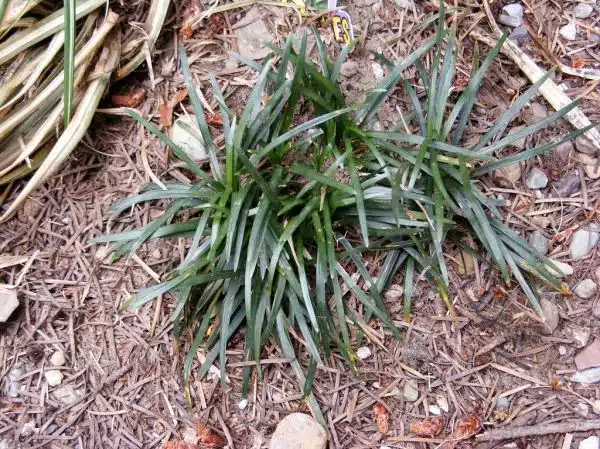Indoor plants not only add beauty to a space, but they also provide numerous benefits such as purifying the air and reducing stress levels. One plant that can offer both aesthetic and functional advantages is the Lilyturf. This versatile plant is easy to care for and can thrive in various indoor settings.
In this guide, we will provide essential information on Lilyturf care and growth. From selecting the right soil type to determining the ideal lighting conditions, we will cover everything you need to know about keeping your Lilyturf healthy and vibrant. Whether you are a seasoned indoor gardener or a beginner looking to add some greenery to your home or office, this guide will serve as an invaluable resource for maximizing your Lilyturf’s potential.
Understanding The Basics Of Lilyturf
Growing plants indoors can be a fulfilling and rewarding experience, however, it is important to choose the right plant that fits your lifestyle and indoor environment. Lilyturf is an excellent choice for those who are new to indoor gardening or looking for a low-maintenance indoor plant. This hardy perennial grass-like plant is not only easy to care for but also has a range of benefits that make it an all-around winner.
One of the benefits of growing lilyturf indoors is its ability to propagate easily. It can be grown from seeds, division, or cuttings, making it an accessible option for beginner gardeners. Propagating lilyturf is also a great way to expand your collection without having to spend money on new plants. Additionally, lilyturf’s rapid growth rate makes it an ideal plant for those who want to see quick results.
Aside from its propagation ease, another benefit of growing lilyturf indoors is its air-purifying qualities. Like many other houseplants, lilyturf can help improve indoor air quality by removing harmful toxins such as formaldehyde and benzene from the air. This makes it an excellent choice for those who live in urban areas or have respiratory issues. In addition, lilyturf’s lush green foliage adds a touch of natural beauty and serenity to any room.
To ensure the success of your lilyturf plants, choosing the right soil is crucial. The next section will delve into the different types of soil that work best for lilyturf and how to prepare them properly for optimal growth.
Choosing The Right Soil For Your Lilyturf
Understanding the Basics of Lilyturf is crucial before embarking on growing this indoor plant. Now that you have a basic understanding of lilyturf, it is time to choose the right soil for your plant. Different types of soil have varying effects on plants, which makes it essential to select the appropriate one for your lilyturf.
Types of Soil: There are several types of soils available in stores, each with its unique properties. Some of them include sandy soil, clay soil, loamy soil, and silt soil. Sandy soil has large particles that allow water to drain quickly but may not retain nutrients effectively. Clay soils are dense and can hold nutrients well but are prone to waterlogging. Loamy soils combine sand, clay, and silt in balanced proportions and make an excellent choice for lilyturf planting.
Soil pH Levels: The pH level is another critical factor when selecting the right type of soil for lilyturf. An optimal pH range between 5.0-7.0 ensures the proper nutrient uptake by the roots and healthy growth of your plant. It is best to test your soil’s pH levels before planting or adjust it if needed using organic amendments.
Providing adequate water and drainage is essential for your lilyturf’s growth and survival. Inadequate drainage can lead to root rot, while overwatering can cause wilting or yellowing leaves. Ensure that you use well-draining pots or mix gravel at the bottom of your container to facilitate effective water drainage. Water regularly but avoid letting standing water accumulate in the pot or saucer.
Choosing the right soil for your lilyturf will ensure optimal growth conditions for this indoor plant species. Consider factors such as type of soil and pH level when selecting a growing medium for your plant species. Remember to provide adequate drainage and watering as well to ensure optimal conditions necessary for healthy growth!
Providing Adequate Water And Drainage
Proper watering and drainage are essential for the health and longevity of your lilyturf plant. Overwatering can lead to root rot, while underwatering can cause the plant to dry out and wither. It is important to find a balance between the two by providing adequate water and drainage.
Watering frequency is dependent on several factors such as temperature, humidity, soil type, and pot size. Generally, it is recommended to water your lilyturf plant once a week during the growing season and reduce watering during the winter months when the plant becomes dormant. However, it is important to check the soil moisture level regularly before watering. A simple way to do this is by sticking your finger into the soil up to your first knuckle; if it feels dry, then it’s time to water.
Good drainage solutions are crucial in preventing overwatering and root rot. Ensure that your pot has drainage holes at the bottom so that excess water can drain out easily. You can also add a layer of gravel or stones at the bottom of the pot before adding soil; this will create a space for excess water to accumulate before draining out. Additionally, you may consider using a well-draining soil mix that will allow water to flow through quickly.
Proper watering and drainage are necessary for ensuring healthy growth of your lilyturf plant. By following these tips on watering frequency and incorporating good drainage solutions such as adding gravel or stones at the bottom of your pot or using well-draining soil mix, you can help ensure optimal growth conditions for your indoor plant. In our next section, we will discuss temperature and humidity requirements for lilyturf plants to further aid in their care and growth.
Temperature And Humidity Requirements For Lilyturf
Lilyturf is a low-maintenance groundcover that grows best in full sun to partial shade and thrives in temperate climates. The optimal temperature range for lilyturf is between 65 and 75 degrees Fahrenheit during the day and between 55 and 65 degrees Fahrenheit at night. High humidity levels are preferable for lilyturf and it should be regularly misted to keep the soil moist. For optimal growth, lilyturf should be exposed to temperatures during the day that are several degrees higher than at night. The temperature should not be allowed to drop below 55 degrees Fahrenheit during the night to prevent damage to the plant. Humidity levels should be kept between 40 and 60 percent for lilyturf to thrive.
Temperature Requirements
Maintaining the ideal temperature is crucial in ensuring your lilyturf thrives indoors. This plant prefers a consistent temperature range between 65 and 75 degrees Fahrenheit. It is essential to keep the indoor environment within this range, especially during winter when indoor heating can cause temperatures to fluctuate drastically.
If you live in an area where temperatures drop significantly at night, consider moving your lilyturf away from windows or doors that let in cold drafts. Additionally, placing your plant near heat sources such as radiators or vents can lead to overheating and damage the leaves. Ensure you monitor the temperature consistently to avoid any extreme variations that could harm your plant’s growth.
In conclusion, keeping up with the ideal temperature requirements for lilyturf may seem challenging, but it is a critical aspect of its care routine. By maintaining a consistent temperature range of 65-75°F, you will promote healthy foliage growth and prevent damage caused by fluctuations. Remember always to monitor the temperature closely and make necessary adjustments to ensure your lilyturf thrives indoors year-round.
Humidity Requirements
Maintaining the ideal temperature for your indoor lilyturf is not the only requirement for its optimal growth. The humidity levels in the environment also play a crucial role in ensuring that your plant thrives indoors. The ideal humidity range for lilyturf is between 40-60%, which can be challenging to maintain during winter when indoor heating dries out the air.
To ensure your lilyturf thrives, it is essential to keep humidity levels consistent by using a humidifier or other methods of humidity control. You may also consider grouping plants together, as they release moisture into the air through transpiration, which can help increase humidity levels. Additionally, maintaining indoor air quality by avoiding tobacco smoke and other pollutants can prevent damage caused by dry air.
In conclusion, maintaining ideal humidity levels in conjunction with the right temperature range is essential for ensuring optimal growth and health of your lilyturf. By controlling indoor air quality and utilizing methods of humidity control such as a humidifier or grouping plants together, you can provide a comfortable environment that promotes healthy foliage growth and prevents damage caused by dry air. Remember always to monitor both temperature and humidity closely and make necessary adjustments to ensure your lilyturf thrives indoors year-round.
Daytime Vs. Nighttime Temperatures
Maintaining the ideal temperature range and humidity levels are critical factors in ensuring optimal growth and health of your indoor lilyturf. However, it is not just about maintaining a consistent temperature and humidity level. It is equally essential to consider the differences between daytime and nighttime temperatures.
Lilyturf requires an optimal temperature range of 60-75°F during the day and 55-65°F at night. To mimic their natural environment, seasonal adjustments may be necessary as colder temperatures can induce dormancy. It is essential to keep the temperature within these ranges as extreme fluctuations can stress the plant, leading to stunted growth or even death.
The effects of temperature on growth and flowering cannot be overstated. A lower night-time temperature helps promote flower formation while higher daytime temperatures encourage foliage growth. Striking a balance between day and night temperatures can help produce healthy foliage while also promoting beautiful blooms. By paying close attention to both daytime and nighttime temperatures, you can create an environment that encourages healthy growth throughout the year without compromising on its beauty.
Lighting Needs For Optimal Growth
It’s a well-known fact that lilyturf is a low-maintenance indoor plant. It can survive in almost any light condition, making it a favorite among those who don’t have much time to dedicate to their plants. However, just because this plant is easy-going doesn’t mean you should neglect its lighting needs. After all, if you want your lilyturf to thrive and look its best, proper lighting is key.
Plant placement plays a significant role in the amount of natural light your lilyturf receives. Ideally, you want to place it near a window that gets bright, indirect sunlight for several hours each day. If that’s not possible, don’t worry – there are plenty of artificial lighting options available that can provide the necessary light for optimal growth. LED grow lights are an excellent choice and come in different spectrums depending on your plant’s needs.
When choosing artificial lighting for your lilyturf, keep in mind the intensity and duration of the light exposure. As a general rule of thumb, your plant needs at least 12-16 hours of light per day during its growing season. You may need to adjust the height and proximity of the light source as your plant grows to ensure it’s getting enough light without being burned. Always read the manufacturer’s instructions for your specific type of grow light before use.
Now that you know about the lighting requirements for your lilyturf let’s move onto another crucial aspect of indoor plant care – fertilizing!
Fertilizing Your Lilyturf
- When fertilizing your lilyturf, it is important to understand the different types of fertilizer available, such as liquid, granular or slow-release forms.
- The type of fertilizer used should be appropriate for the specific conditions of your growing environment.
- As lilyturf is a slow-growing plant, it is recommended to fertilize it every two to three months.
- The amount of fertilizer should be based on the manufacturer’s instructions, as over-fertilization can damage the plant.
Types Of Fertilizer
When it comes to fertilizing your lilyturf, there are many types of fertilizer to choose from. Organic and synthetic fertilizers are the two main categories. Organic fertilizers come from natural sources such as compost, manure, and bone meal. They release nutrients slowly over time and help improve soil health. Synthetic fertilizers, on the other hand, are made with chemicals in a lab and provide an immediate boost of nutrients to plants.
Another factor to consider when choosing a fertilizer for your lilyturf is whether to use slow-release or liquid fertilizers. Slow-release fertilizers are designed to gradually release nutrients over several weeks or months. They provide a steady supply of nutrients to the plant and reduce the risk of over-fertilization. Liquid fertilizers, on the other hand, are fast-acting and quickly absorbed by plants. They are often used for foliar feeding, which involves spraying the leaves of plants with a diluted fertilizer solution.
When selecting a fertilizer for your lilyturf, it’s important to consider both the type of fertilizer (organic vs. synthetic) and the delivery method (slow-release vs. liquid). Each option has its pros and cons depending on your specific needs and preferences as a gardener. By carefully considering these factors, you can select a fertilizer that will help your lilyturf thrive while also being mindful of environmental impact and sustainability practices.
Fertilizing Frequency
Now that we have discussed the types and delivery methods of fertilizers, let’s move on to another crucial aspect of fertilizing your lilyturf – frequency. Fertilizing frequency refers to how often you should apply fertilizer to your plant. This is an essential factor as it can significantly impact the health and growth of your lilyturf.
When it comes to fertilizing frequency, there are many factors to consider, such as the type of fertilizer used and the age of your lilyturf. For example, organic fertilizers typically release nutrients slowly over time, so they require less frequent application than synthetic fertilizers. On the other hand, younger plants may require more frequent fertilization than mature ones.
Generally speaking, it is best to fertilize your lilyturf once every three to four weeks during the growing season. However, keep in mind that this frequency may vary depending on environmental factors such as temperature and humidity levels. Over-fertilization can also be harmful to your lilyturf, so it’s essential to follow the instructions on the fertilizer packaging carefully. By maintaining a consistent and appropriate fertilizing schedule for your lilyturf, you can ensure optimal growth and health for years to come.
Repotting And Transplanting Tips
Repotting and transplanting is necessary to keep your lilyturf plant healthy and vibrant. Benefits of repotting include providing fresh soil, more space for roots to grow, and the removal of any diseased or damaged roots. It’s important to repot your lilyturf plant every 2-3 years, or when you notice signs of overgrown roots such as stunted growth or roots growing out of the bottom drainage holes.
When repotting your lilyturf plant, make sure to choose a pot that is only one size larger than the current pot. This will prevent the plant from becoming overwhelmed by too much soil and water. Fill the new pot with fresh potting soil and gently remove the plant from its old pot. Carefully loosen any tangled roots and trim any damaged or diseased ones before placing it in the new pot. Water thoroughly after transplanting.
Transplanting outdoors can be done in early spring or fall when temperatures are cooler. Choose a spot that receives partial shade as lilyturf plants prefer shaded areas with well-draining soil. Dig a hole twice as wide as the root ball, place the plant in the hole, and fill with soil. Water thoroughly after planting.
Incorporate this helpful table into your decision-making process:
| Signs of Overgrown Roots | Benefits of Repotting |
|---|---|
| Stunted Growth | Fresh Soil |
| Roots Growing Out | More Space |
| Bottom Drainage Holes | Removal of Diseased |
Now that you’ve learned about repotting and transplanting tips for your lilyturf plant, it’s time to move on to pruning and propagation techniques. These techniques are essential for maintaining a healthy and thriving indoor garden.
Pruning And Propagation Techniques
Pruning and Propagation Techniques: A Guide for Lilyturf Care
Pruning techniques are essential in maintaining the overall health and appearance of lilyturf plants. Regular pruning promotes new growth, controls plant size, and enhances the plant’s natural shape. To prune your lilyturf, use a sharp, clean pair of scissors or pruning shears to remove any dead or damaged foliage as well as any stems that are crossing over each other. Be sure to make clean cuts at an angle just above a leaf node.
Propagation methods for lilyturf involve dividing mature plants into smaller sections, which can be replanted to form new plants. The best time to divide lilyturf is in early spring or late fall when the plant is dormant. Gently dig up the entire clump of lilyturf using a garden fork or spade, then carefully separate it into smaller sections with a sharp knife or garden shears. Replant each section in well-draining soil and water thoroughly.
By mastering these pruning and propagation techniques, you can ensure that your lilyturf will thrive year after year. With proper care, your plants will remain healthy and vibrant while adding beauty to any indoor space. In the next section, we will discuss common pests and diseases to watch out for when caring for your lilyturf plant.
Common Pests And Diseases To Watch Out For
Identifying symptoms of pests and diseases in lilyturf plants is crucial for maintaining their overall health. Common pests that can infest lilyturf plants include spider mites, mealybugs, and scale insects. Spider mites typically cause yellowing or stippling of leaves, while mealybugs create white cotton-like substances on the leaves and stems. Scale insects are known to produce a sticky substance that attracts ants.
In addition to pests, lilyturf plants can also suffer from various diseases such as root rot and leaf spot. Root rot is caused by waterlogged soil, leading to the decay of roots and eventual death of the plant. Leaf spot manifests as brown spots on the leaves and can be caused by overwatering or high humidity levels.
Fortunately, there are natural remedies available for controlling pests and diseases in lilyturf plants. For instance, neem oil is an effective insecticide that can repel spider mites and other pests. Additionally, a mixture of baking soda and water can help treat leaf spot disease. To prevent root rot, it’s important to avoid overwatering the plant and ensure proper drainage in its potting soil. By identifying symptoms early on and utilizing natural remedies, you can maintain healthy lilyturf plants in your indoor garden.
Transition: Now that we’ve discussed common pests and diseases to watch out for when caring for your lilyturf plant let’s move on to troubleshooting common issues with your plant growth.
Troubleshooting Common Issues With Your Lilyturf
After knowing the common pests and diseases that can affect your lilyturf, it is essential to learn how to troubleshoot issues that may arise. Two of the most common problems you may encounter are yellowing leaves and wilting tips. Yellow leaves can indicate a problem with the plant’s nutrient intake or an overwatering issue. In contrast, wilting tips can be caused by underwatering or too much direct sunlight exposure.
To address yellowing leaves or wilting tips, first check on your plant’s watering schedule and adjust it accordingly. Ensure that you are not over or underwatering your lilyturf and maintain a consistent watering routine. If this does not solve the problem, consider changing its location to avoid excessive sunlight exposure or drafty areas. Another issue you may face is brown spots on your lilyturf’s leaves, which can be a sign of fungal disease or root rot. Brown spots indicate that there is too much moisture in the soil, which can lead to root rot if left untreated.
To prevent brown spots and root rot from spreading, remove any affected leaves immediately and cut back on watering until you notice improvement in your plant’s condition. You can also try using a fungicide on the affected area to kill any remaining fungus spores.
- Check watering schedule
- Adjust location for sunlight exposure
- Remove affected leaves
- Use fungicide
By taking care of these common issues promptly, you can help ensure the healthy growth of your lilyturf plant for years to come!
Conclusion
Lilyturf is an excellent indoor plant that can bring life and beauty to any space. Understanding the basics of lilyturf care is crucial for ensuring its long-term health and growth. When choosing soil for your lilyturf, it’s essential to pick a well-draining option that allows water to pass through easily. Adequate water and drainage are critical factors in keeping your lilyturf healthy. Temperature and humidity requirements should also be carefully considered, as should lighting needs.
Repotting and pruning techniques can help promote optimal growth, while propagation can allow you to create new plants from existing ones. However, gardeners must beware of common pests and diseases that can affect their lilyturf’s health. By troubleshooting common issues promptly, you can keep your lilyturf looking beautiful for years to come.
According to recent research by the National Gardening Association, over 30 million households in the United States grow indoor plants. As such, it’s clear that more people are turning to indoor gardening as a way to beautify their homes while reaping the benefits of improved air quality and mental wellbeing. By following this guide on lilyturf care, you’ll be better equipped to keep your indoor plants healthy and thriving!
Image Credits
- “Liliaceae Ophiopogon japonicus, Mondo Grass, Lilyturf” by vikisuzan (featured)





























